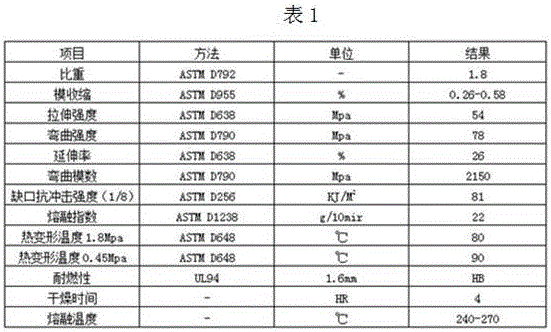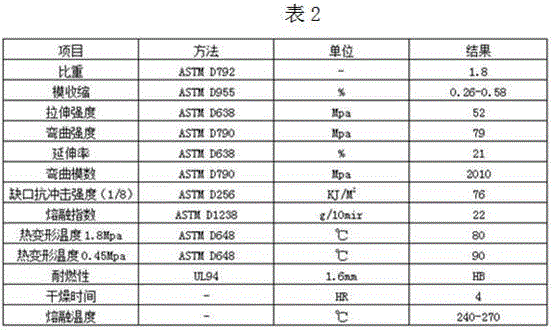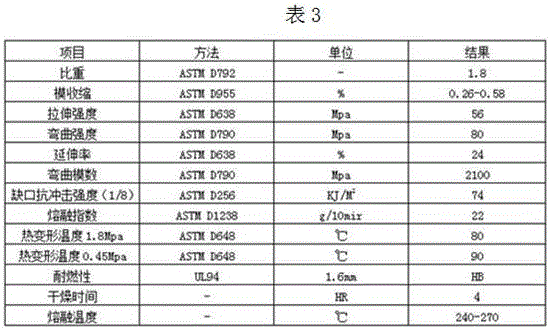PBT/PC alloy material and preparation method and application thereof
An alloy material, PBT6.5-42.6 technology, applied in the field of PBT/PC alloy material and its preparation, can solve the problems of insufficient product strength, cracking, and easy breakage
- Summary
- Abstract
- Description
- Claims
- Application Information
AI Technical Summary
Problems solved by technology
Method used
Image
Examples
Embodiment 1
[0018] The present embodiment provides a kind of PBT / PC alloy material, and its raw material comprises by weight:
[0019] 31.2 copies of PBT;
[0020] PC 80 copies;
[0021] 0.5 part of transesterification inhibitor;
[0022] The raw materials of the transesterification inhibitor include by weight 2 parts of aluminum silicate, 0.03 part of diethanol monoisopropanolamine, 0.7 part of sodium lauryl sulfate, 3 parts of copper hydroxide, 0.2 part of sodium citrate, 0.07 Parts of fluoroantimonysulfonic acid.
[0023] The preparation method of the transesterification inhibitor is to add the magnesium sulfate and copper hydroxide into a mixture of deionized water and 3 times ethanol whose mass is 100 times the mass of the two, stir and heat to 80 ° C, add The aluminum silicate, diethanol monoisopropanolamine, copper hydroxide, sodium citrate, and sodium lauryl sulfate were kept for 50 minutes, then cooled to 50°C, and mixed with fluoroantimonysulfonic acid, then heated at 45°C E...
Embodiment 2
[0030] The present embodiment provides a kind of PBT / PC alloy material, and its raw material comprises by weight:
[0031] 6.5 copies of PBT;
[0032] PC 90 copies;
[0033] 0.2 part of transesterification inhibitor;
[0034] The raw materials of the transesterification inhibitor include by weight 2 parts of aluminum silicate, 0.03 part of diethanol monoisopropanolamine, 0.7 part of sodium lauryl sulfate, 3 parts of copper hydroxide, 0.2 part of sodium citrate, 0.07 Parts of fluoroantimonysulfonic acid.
[0035] The preparation method of the transesterification inhibitor is to add the magnesium sulfate and copper hydroxide into a mixture of deionized water and 3 times ethanol whose mass is 100 times the mass of the two, stir and heat to 80 ° C, add The aluminum silicate, diethanol monoisopropanolamine, copper hydroxide, sodium citrate, and sodium lauryl sulfate were kept for 50 minutes, then cooled to 50°C, and mixed with fluoroantimonysulfonic acid, then heated at 45°C Ev...
Embodiment 3
[0042] The present embodiment provides a kind of PBT / PC alloy material, and its raw material comprises by weight:
[0043] 42.6 copies of PBT;
[0044] PC 70 copies;
[0045] 0.7 part of transesterification inhibitor;
[0046] The raw materials of the transesterification inhibitor include by weight 2 parts of aluminum silicate, 0.03 part of diethanol monoisopropanolamine, 0.7 part of sodium lauryl sulfate, 3 parts of copper hydroxide, 0.2 part of sodium citrate, 0.07 Parts of fluoroantimonysulfonic acid.
[0047] The preparation method of the transesterification inhibitor is to add the magnesium sulfate and copper hydroxide into a mixture of deionized water and 3 times ethanol whose mass is 100 times the mass of the two, stir and heat to 80 ° C, add The aluminum silicate, diethanol monoisopropanolamine, copper hydroxide, sodium citrate, and sodium lauryl sulfate were kept for 50 minutes, then cooled to 50°C, and mixed with fluoroantimonysulfonic acid, then heated at 45°C Eva...
PUM
 Login to View More
Login to View More Abstract
Description
Claims
Application Information
 Login to View More
Login to View More - R&D Engineer
- R&D Manager
- IP Professional
- Industry Leading Data Capabilities
- Powerful AI technology
- Patent DNA Extraction
Browse by: Latest US Patents, China's latest patents, Technical Efficacy Thesaurus, Application Domain, Technology Topic, Popular Technical Reports.
© 2024 PatSnap. All rights reserved.Legal|Privacy policy|Modern Slavery Act Transparency Statement|Sitemap|About US| Contact US: help@patsnap.com










